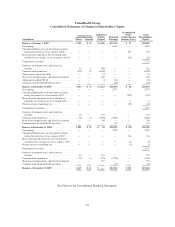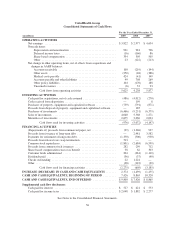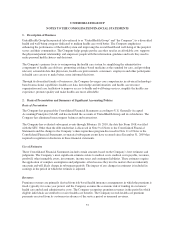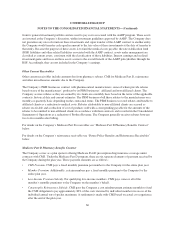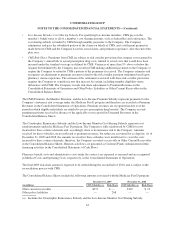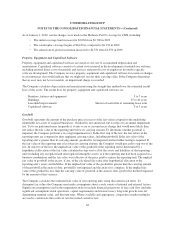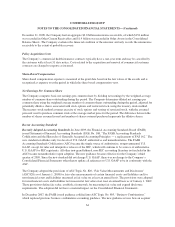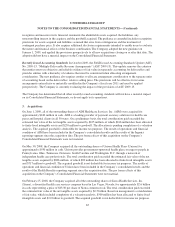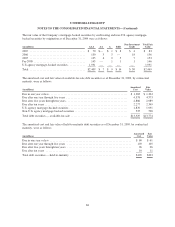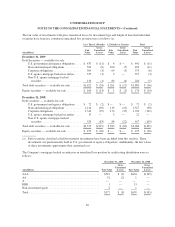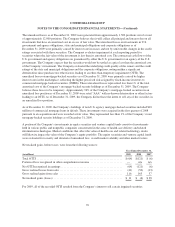United Healthcare 2009 Annual Report Download - page 64
Download and view the complete annual report
Please find page 64 of the 2009 United Healthcare annual report below. You can navigate through the pages in the report by either clicking on the pages listed below, or by using the keyword search tool below to find specific information within the annual report.UNITEDHEALTH GROUP
NOTES TO THE CONSOLIDATED FINANCIAL STATEMENTS—(Continued)
As of January 1, 2010, certain changes were made to the Medicare Part D coverage by CMS, including:
• The initial coverage limit increased to $2,830 from $2,700 in 2009.
• The catastrophic coverage begins at $6,440 as compared to $6,154 in 2009.
• The annual out-of-pocket maximum increased to $4,550 from $4,350 in 2009.
Property, Equipment and Capitalized Software
Property, equipment and capitalized software are stated at cost, net of accumulated depreciation and
amortization. Capitalized software consists of certain costs incurred in the development of internal-use software,
including external direct costs of materials and services and payroll costs of employees devoted to specific
software development. The Company reviews property, equipment and capitalized software for events or changes
in circumstances that would indicate that we might not recover their carrying value. If the Company determines
that an asset may not be recoverable, an impairment charge is recorded.
The Company calculates depreciation and amortization using the straight-line method over the estimated useful
lives of the assets. The useful lives for property, equipment and capitalized software are:
Furniture, fixtures and equipment 3 to 7 years
Buildings 35 to 40 years
Leasehold improvements Shorter of useful life or remaining lease term
Capitalized software 3 to 5 years
Goodwill
Goodwill represents the amount of the purchase price in excess of the fair values assigned to the underlying
identifiable net assets of acquired businesses. Goodwill is not amortized, but is subject to an annual impairment
test. Tests are performed more frequently if events occur or circumstances change that would more likely than
not reduce the fair value of the reporting unit below its carrying amount. To determine whether goodwill is
impaired, the Company performs a two-step impairment test. In the first step of the test, the fair values of the
reporting units are compared to their aggregate carrying values, including goodwill. If the fair value of the
reporting unit is greater than its carrying amount, goodwill is not impaired and no further testing is required. If
the fair value of the reporting unit is less than its carrying amount, the Company would proceed to step two of the
test. In step two of the test, the implied fair value of the goodwill of the reporting unit is determined by a
hypothetical allocation of the fair value calculated in step one to all of the assets and liabilities of that reporting
unit (including any recognized and unrecognized intangible assets) as if the reporting unit had been acquired in a
business combination and the fair value was reflective of the price paid to acquire the reporting unit. The implied
fair value of goodwill is the excess, if any, of the calculated fair value after hypothetical allocation to the
reporting unit’s assets and liabilities. If the implied fair value of the goodwill is greater than the carrying amount
of the goodwill at the analysis date, goodwill is not impaired and the analysis is complete. If the implied fair
value of the goodwill is less than the carrying value of goodwill at the analysis date, goodwill is deemed impaired
by the amount of that variance.
The Company calculates the estimated fair value of our reporting units using discounted cash flows. To
determine fair values the Company must make assumptions about a wide variety of internal and external factors.
Significant assumptions used in the impairment analysis include financial projections of free cash flow (includes
significant assumptions about operations, capital requirements and income taxes), long-term growth rates for
determining terminal value, and discount rates. Where available and appropriate, comparative market multiples
are used to corroborate the results of our discounted cash flow test.
62





